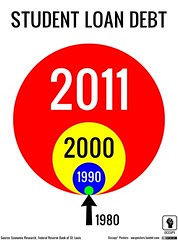Falling Behind On Student Loans? There are Options
 (Photo credit: Occupy* Posters)
(Photo credit: Occupy* Posters)
The Consumer Financial Protection Bureau has partnered with the U.S. Department of Education to release a new web tool for borrowers who have fallen behind on their student loan payments. The tool should help borrowers learn about their options. It’s never a good idea to just ignore the problem.
Student loan default is a looming problem in the U.S. Over a quarter of all student loan borrowers are at least one monthly payment behind. Millions of federal student loan borrowers have defaulted on their loans.
The unemployment rate among new college graduates is more than twice that of their older counterparts. More than a third of college graduates under age 25 have taken jobs that do not require a college degree.
Over the past decade, student debt has grown to an average of over $22,000 for graduates of public colleges and universities and over $28,000 for private school grads. That’s a 20% increase. A growing number of borrowers – greater than one in eight – have debts of $50,000 or more. For too many, this grim economic reality makes making each loan payment in-full and on-time a monthly struggle.
Student loan default is a looming problem in the U.S. Over a quarter of all student loan borrowers are at least one monthly payment behind. Millions of federal student loan borrowers have defaulted on their loans.
The unemployment rate among new college graduates is more than twice that of their older counterparts. More than a third of college graduates under age 25 have taken jobs that do not require a college degree.
Over the past decade, student debt has grown to an average of over $22,000 for graduates of public colleges and universities and over $28,000 for private school grads. That’s a 20% increase. A growing number of borrowers – greater than one in eight – have debts of $50,000 or more. For too many, this grim economic reality makes making each loan payment in-full and on-time a monthly struggle.
There are serious consequences of loan default. there can be thousands of dollars in penalties and fees. Your credit can be damaged for many years to come keeping you from other types of consumer loans, car loans, and mortgages. The worse part and not known by many people is that you can not discharge your student loan debt in bankruptcy. This debt you owe will be with you from now on.
The only good point to being in default is you cannot qualify for income-based repayment, an alternative payment plan can have a monthly payment as low as zero for extremely low-income borrowers.
If you’ve fallen behind on your loans, check out our new web tool, available here on ConsumerFinance.gov and at the new StudentAid.gov, launched by the U.S. Department of Education earlier this week.





